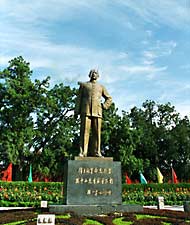 Zhongshan Park is located to the west of Tian?anmen Rostrum in the heart of the Inner City. It is the site of the former Altar of Land and Grain.
Zhongshan Park is located to the west of Tian?anmen Rostrum in the heart of the Inner City. It is the site of the former Altar of Land and Grain.
Entering through the main southern entrance, one comes to a large vestibular pavilion with long corridors running off to the east and west. In front of the pavilion is a white marble memorial archway erected by the Qing government to commemorate the German Minister Baron von Kettler, who was killed during the Yihetuan Movement (?Boxer Rebellion?) in 1900. This archway originally stood outside the western entrance to the Xizongbu Alley, but after Germany? s defeat in World War I, it was removed to the Zhongshan Park and inscribed with the words?Triumph of Righteousness?(Gongli Zhansheng). After 1949 it was rein scribed in Guo Moruo? s handwriting with?Defeat the Peace?(Baowei Heping).
To the east stands a beautiful specimen of Taihu Lake stone known as?a slice of dark clouds,? which was moved here from Yuanmingyuan. Emperor Qianlong composed its inscription. There is a peony pond, a wisteria arbor and, to the north, a grove of cypresses with trees said to have been planted in the Liao Dynasty. Seven of the trees are so large that it takes three of four persons with arms outstretched to encircle the trunk. One of the cypresses on the eastern side is particularly unusual, because a scholar trees is called ?the embrace of the scholar tree and the cypress.? The path that runs through the archway is lined with umbrella-like scholar trees and verdant pines.
On the southern side of this east-west path lies a greenhouse with fresh flowers on display all year round. Included are 39 varieties of tulips presented to the park in 1977 by the Princess of Holland. The eight ?Orchid Pavilion? stela, standing inside a hall nearby, are engraved in the hand of Emperor Qianlong with the text of a famous preface to a collection of poems entitled the Orchid Pavilion. The Pavilion Where the RITES Are Practiced was moved to the Zhongshan Park from the Honglu Court, an office which during the Ming and Qing dynasties. In imperial times all officials coming to the capital to be received by the emperor for the first time went first to the Honglu Court to learn the proper protocol.
To the south of this path there is also a display of rare goldfish. Further south, one comes to the quietest spot in the park, the area of the Lotus Pool, Water-side Pavilion, Pavilion of Four Contentment and the Pavilion to Welcome the Sunshine.
On the north side of the path is the Altar of Land and Grain. Here the landscape is particularly charming. With the lofty Concert Hall to the east and the Health Education hall to the west. The area is planted with numerous fruit trees, herbaceous peonies and green lawns. A wide path through the center of the lawns leads to the altar.
To the east of the altar is the Pavilion of the Pines and Cypresses and a tall rockery. Footpaths lead to secluded nooks and wind their ways to the cross-shaped Touhu Pavilion, which takes its name from an old game of throwing arrows into a pot. South of this building lies the Kiosk for Meeting New Friends (Laijinyuxuan) where refreshments are sold.
To the west of the Altar of Land and Grain is the liveliest part of the park. Here among a forest of cypress trees stand artificial hills, thatched pavilions, a teahouse, a restaurant, a children? s playground and an amusement park.
To the north of the altar past the Zhongshan Hall is another copse of cypress trees, among which is a stone table built of hollow bricks dating from the Han Dynasty. The classically elegant designs on the old bricks are still quite distinct. The moat (Tongzihe or Tube River) is also known as the Imperial River (Yuhe) and is used for ice skating in the winter and boating during the summer and autumn.
Over 1,000 years ago the site of Zhongshan Park was the Temple of National Prosperity, which stood in the northeast suburbs of Yanjing, the Liao Dynasty capital. Under the Yuan Dynasty, the name of the temple was changed to the Temple of Longevity and National Prosperity. Although no traces of the old buildings remain, the ancient cypresses planted inside the temple serve as a reminder of those days. In 1421, the Ming Emperor Yongle built the Altar of Land and Grain symmetrically opposite the Imperial Ancestral (Taimiao) Temple, which stands to the east of Tian?anmen Rostrum. In 1914, the altar was renamed Central Park and opened to the public on October 10. In 1928, the park was renamed Zhongshan Park in tribute to the memory of Sun Yat-sen.












